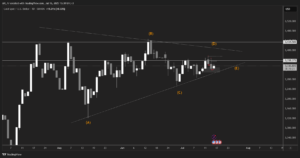Oil rises to a second weekly increase, supported by strong demand.
Oil prices rose on Friday, July 7, on their way to recording a second consecutive weekly gain, as strong demand led to a larger-than-expected decline in US crude inventories, outweighing concerns about the repercussions of interest rate hikes in the United States.
Brent crude futures rose by 33 cents or 0.43% to $76.85 per barrel, while US crude increased by 36 cents, equivalent to 0.36%, to $72.16 per barrel.
Both crude oil benchmarks are expected to rise by around 2% for the second week.
The US Energy Information Administration said crude inventories in the United States declined more than expected. In contrast, gasoline inventories significantly decreased following increased driving rates last week.
This comes at a time when Saudi Arabia and Russia announced a new round of production cuts for August. The total production cuts now amount to five million barrels daily, or about 5% of global oil production.
However, expectations that the US Federal Reserve will raise interest rates at its meeting on July 25 and 26 have led to the curbing of oil prices.
Data released on Thursday showed that the number of Americans filing new claims for unemployment benefits recorded a moderate increase last week. At the same time, private sector employment jumped in June, increasing the likelihood of the Federal Reserve raising interest rates this month.
High-interest rates lead to increased borrowing costs for companies and consumers, which may slow economic growth and reduce the oil demand.
Sources close to OPEC stated that it is likely that the organization will maintain its optimistic outlook on oil demand growth for the coming year when it publishes its first forecasts for 2024 this month. It is expected to anticipate a slowdown compared to the current year, but the increase will remain above average.
The dollar remains stable as the US economy continues to show strength.
The dollar moved within narrow ranges on Friday, July 7, as investors awaited a key report on US jobs and assessed the possibility of the US Federal Reserve raising interest rates for a longer period amid economic growth expectations.
The non-farm payrolls report in the United States is scheduled to be released later today, with forecasts indicating that the US economy added 225,000 jobs in June.
This report comes after Thursday’s data, which showed a surge in private-sector employment last month and a moderate increase in the number of Americans filing new claims for unemployment benefits last week, indicating that the labor market remains strong.
This led to increased US Treasury bond yields as bets grew that the central bank should continue to raise interest rates to curb inflation, keeping the dollar elevated in early Asian trading today, Friday.
- DXY: The dollar index rose by 0.03% to 103.12 points.
- EUR/USD: Against the US currency, the euro declined by 0.02% to $1.0890, while the New Zealand dollar increased by 0.09% to $0.6163, recovering some of its losses from the previous session.
- GBP/USD: The British pound was also lower against the dollar, recording $1.2734 in the latest trading.
This came despite its rise on Thursday to the highest level in two weeks at $1.2780, as markets bet that the Bank of England will raise interest rates to 6.5% early next year, compared to previous expectations of a hike to 6.25%.
- USD/JPY: The yen recorded 144.06 against the dollar in the latest trading and is on track to achieve slight weekly gains after three consecutive weeks of losses.
- AUD/USD: The Australian dollar rose by 0.09% to $0.66315 but appears to be heading for a third consecutive weekly loss under pressure from China’s sluggish economic recovery.
Meta stock relinquished its highest levels in 17 months despite the strong launch of Threads.
US indices closed sharply lower on Thursday’s session as data indicating labor market flexibility and the June Federal Reserve meeting minutes raised concerns that the central bank may keep interest rates high for a longer period.
The ADP National Employment Report showed a greater-than-expected increase in private sector jobs in June, suggesting that the labor market remained strong despite growing recession risks due to rising interest rates.
Another survey indicated a moderate increase in the number of Americans filing new claims for unemployment benefits last week. The Dow Jones index fell by 1.07%, equivalent to 366 points, marking its largest daily loss in two months.
The S&P 500 and Nasdaq indices declined by approximately 0.79% and 0.82%, respectively.
- Meta stock:
Meta stock declined by about 0.8%, dropping from its highest levels in 17 months, despite the strong launch of the Threads application, which attracted millions of users within hours of its release on Wednesday.
- Exxon Mobil stock:
Exxon Mobil stock declined by 3.7%, recording its largest daily loss in two months. This came after regulatory documents indicated a sharp decline in operating profits in the second quarter due to lower natural gas prices and weaker refining margins.
Disclaimer: This article is not investment advice or an investment recommendation and should not be considered as such. The information above is not an invitation to trade and it does not guarantee or predict future performance. The investor is solely responsible for the risk of their decisions. The analysis and commentary presented do not include any consideration of your personal investment objectives, financial circumstances, or needs.





